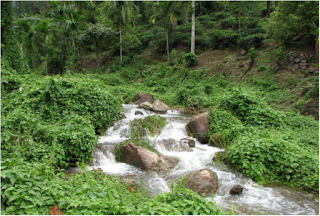Western Ghats is the catchment area of 3 large
rivers, 13 medium and 17 minor rivers which play a crucial role in the rich
biodiversity of the region and the prosperity of some 105 million people living
in the area. However, these blood lines of the region are under threat mainly
from the burgeoning anthropogenic factors in the name of development and flawed
policies.
 |
| Abundance of Globally Threatened fish species in the Western Ghats Rivers |
According to an in-depth study report
submitted to the Western Ghats Ecology Expert Panel about major threats to the
riverine ecosystem in the region, dams, mining, tourism, pollution, flawed
agriculture practices and deforestation of the riparian cover (forest patches
along the river banks) are causing visible degradation to the riverine
ecosystems in this World Heritage site. However, K. A. Subramanian who made the
study also includes the presence of alien species in the riverine ecosystems in
the region as another threat.
Alien species, despite their name, do not
come from another planet, but are introduced from non-native ecosystems often
for agricultural purposes, as ornamental organisms or even as biological
controllers. IUCN has identified introduction of invasive as one of the
possible reason for the population decline of native organisms.
Invasive Plant Species in Western Ghats Rivers
Many of the aquatic invasive species in
streams and water bodies in the Western Ghats like Salvinia molesta, Pistia
stratiotes, Eichhornia crassipes, Hydrilla and Ipomea
fistulosa were first introduced as
ornamental plants in aquariums. They later found their ways to the water
bodies, now spreading to almost all rivers in the Western Ghats.
The changes
in the flow pattern and excessive pollution have also helped in the spread of
these weeds, especially in catchments which are reeling under the pressure of
populated areas. By spreading over the water, they clog the flow of the stream
and increase the rate of sedimentation. They cover the water surface, often
without allowing the sunlight to pass through, eventually wiping away the
submerged species of plants by blocking their chances of photosynthesis.
Mikania
macarantha – a Green Threat to the Riparian Biodiversity
Mikania macarantha, is a similar weed which raises
serious threat to other plant species in the streams and riparian ecosystem of
the rivers in the Western Ghats. This plant forms a thick layer over the stream
and the associated riparian forest blocking the sunlight.
 |
| Mikania macarantha, an invasive plant in WG rivers |
It is
often observed that the invasion of the Mikania macarantha is closely
connected to the presence of degraded riparian forest patches in the course of
the stream. For instance, in many places like Agasthyarmalai and Anamali
region, the weed has been observed as first colonizing streams using degraded
shores in estates and forestry plantations, gradually invading into the healthy
riparian cover in the adjacent forest areas in the upstream gradually degrading
them over a period f time.
Exotic fishes: friend- turned foes?
Exotic
fishes are another destructive species which is raising serious threat to
native organisms in the Western Ghats Rivers. Introduced for aquarium trade, fish farming and as biological controllers, they have invaded the rivers
spreading all over the river network in the area.
Gambusia affinis was widely used as a biological
agent to check the growth of mosquitos. However, their introduction to water
bodies in the region paved their way to reaching Western Ghats wide river
ecosystems. The species have now reportedly colonized many hill streams,
especially in parts of Maharashtra. Though they don’t eat up each and every
native species like some other invasive species do, they raise fierce
competition for resources with native species, often wiping them away locally.
 |
| Clarias gariepinus |
Clarias gariepinus, the notorious African catfish pet
named African Mushi among fish farmers in Kerala and neighboring states, has
made a bad example of bringing in foreign species for increased production.
According
to an IUCN report on threats on fish diversity in Western Ghats Rivers, Cyprinus
carpio, Oncorhyncus mykiss, Pangasianodon hypophthalmus, Oreochromis
niloticus, O. mossambicus, Osphronemus goramy, Pterygoplichthys
multiradiatus, Piaractus brachypomus, Trichopodus trichopterus, Xiphophorus
maculatus, Poecilia reticulata and Gambusia affinis are listed as
major invasive threats.
Among
these, C. carpio, O. mykiss, G. affinis and O. mossambicus
are listed among the top hundred worst invasice alien species database.
According to IUCN, these dangerous species are more present in the Southernregion of the Western Ghats where the endemism is highest compared to other
areas.
Absence of a national policy for managing invasive species
According
to the report submitted to the Convention on Protection of Wetlands, Government
of India admits that presence of invasive species has been raising serious
threat to the conserved areas in the country. The document also admits that
there is no management policy or guidelines issued in this direction. But the
government should take immediate actions to make a management policy to check
more invasive species reaching to the pristine ecosystems and degrading them
gradually.

Most fresh water system pollution indicators are Eichornia. Manual clearing is a simple way of controlling the weed seasonally to protect water bodies.
ReplyDeleteThe truth about the invasive species is that they could get your lakes or riverine systems eutrophic. High nutrient inlets should be monitored by the Public works department for retaining the river network downflow.
ReplyDelete